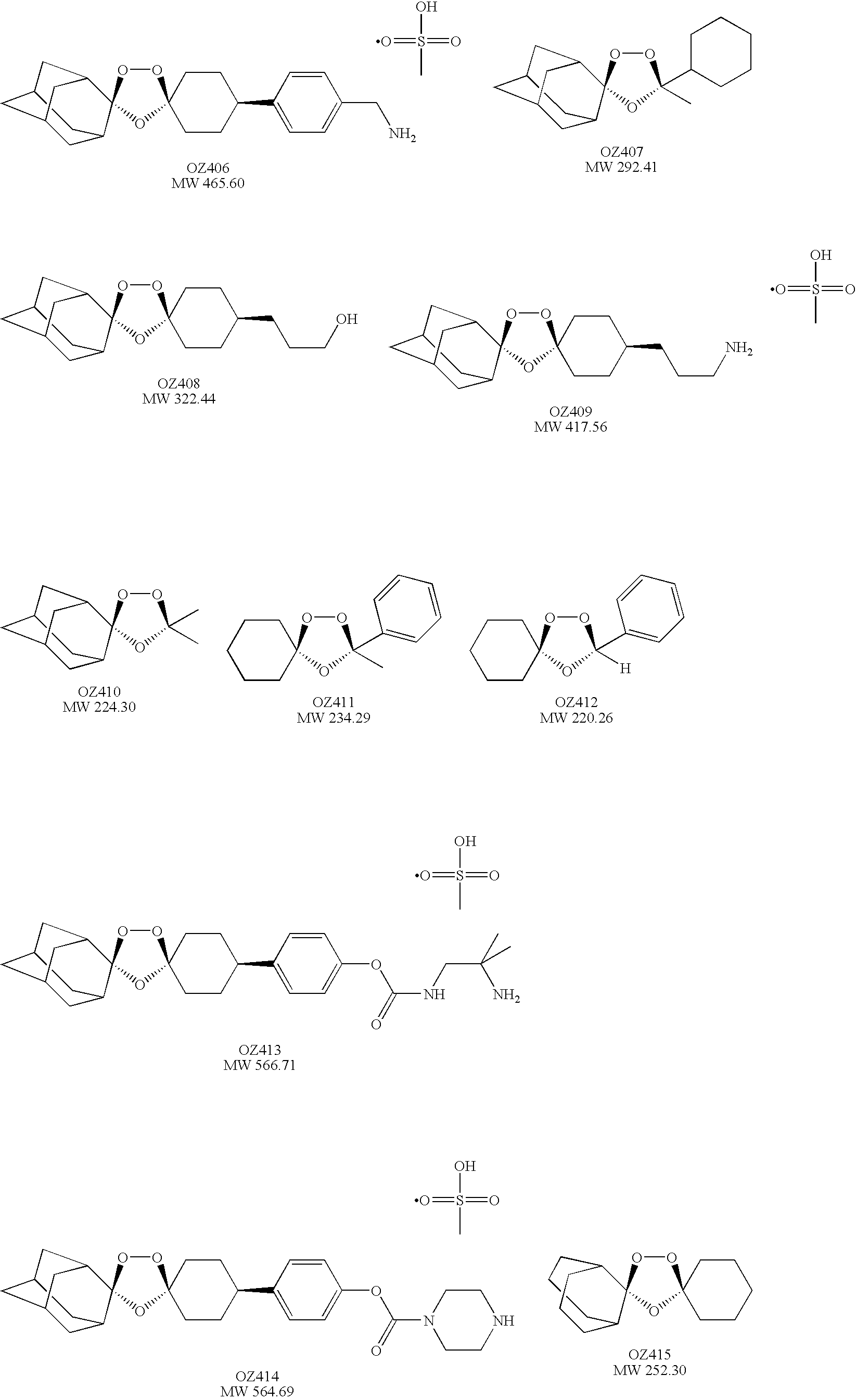Spiro and dispiro 1,2,4-trioxolane antimalarials
a trioxolane and antimalarial technology, applied in the field of compositions and methods for treating malaria, can solve the problems of inability to prevent disease recurrence, difficult treatment of malaria, and exhausted infected individuals, and achieve the effect of easy and inexpensive synthesizing, excellent potency and efficacy
- Summary
- Abstract
- Description
- Claims
- Application Information
AI Technical Summary
Benefits of technology
Problems solved by technology
Method used
Image
Examples
example 1
Antimalarial Activity of New OZ Compounds
[0048]Activity of 1,2,4-trioxolanes against P. falciparum in vitro. Each trioxolane was screened against the chloroquine-resistant K1 and chloroquine-sensitive NF54 strains of Plasmodium falciparum in vitro.
[0049]Activity of 1,2,4-trioxolanes against P. berghei in vivo. In the single dose in vivo screen, Moro or NMRI mice infected with the ANKA strain of P. berghei (groups of five mice) were treated one day post-infection with trioxolanes dissolved or suspended in standard suspending vehicle (SSV). The SSV consists of 0.5% w / v CMC, 0.5% v / v benzyl alcohol, 0.4% v / v Tween 80, and 0.9% w / v sodium chloride in water. Trioxolanes were administered as single po 3 or 30 mg / kg doses. Trioxolanes were also administered as single po 100 mg / kg doses in a tween / ethanol (T / A) vehicle. The T / A consists of 3% ethanol and 7% Tween 80. Antimalarial activity was measured by percent reduction in parasitemia on day three post-infection and survival times compare...
example 3
Preferred Procedures for Preparation of Compounds
[0053]cis-Adamantane-2-spiro-3′-8′-[4′-(aminomethyl)phenyl]-1′,2′,4′-trioxaspiro[4.5]decane mesylate (OZ406). Step 1. To a stirred solution of 1 M TiCl4 in CH2Cl2 (125 ml, 125 mmol) at 0° C. was added a solution of 4-phenylcyclohexanone (8.72 g, 50 mmol) in CH2Cl2 (40 ml) followed by a solution of chloromethyl methyl ether (6.04 g, 75 mmol) in CH2Cl2 (20 ml). After 1 h, an additional amount of chloromethyl methyl ether (6.04 g, 75 mmol) in CH2Cl2 (20 ml) was added dropwise. After being stirred for an additional 1.5 h, the reaction mixture was poured into 300 ml of 12% aq. HCl. The organic phase was separated, washed with water, aqueous NaHCO3, water, and brine, and dried over MgSO4. After removal of the solvent, the residue was purified by chromatography (silica gel, chloroform) followed by crystallization from hexane-chloroform (4:1) at 0° C. to give the chloromethyl ketone (2.5 g, 23%). 1H NMR (500 MHz, CDCl3) δ 1.89-1.97 (m, 2H), 2...
example 4
Treatment of Fascioliasis Using Trioxolanes
Materials and Methods
[0165]OZ72, OZ78, OZ352, and OZ418 were prepared as a suspension in 7% (v / v) Tween-80 and 3% (v / v) ethanol before oral administration. Metacercariae of F. hepatica were purchased from G. Graham (Addlestone, UK). Female Wistar rats (n=32, age: 5 weeks, weight: ˜100 g) were purchased from RCC (Itingen, Switzerland). Animals were kept in groups of 5 in macrolon cages in environmentally-controlled conditions (temperature: ˜25° C.; humidity: ˜70%; 12 h light / dark cycle) and acclimatized for 1 week. They had free access to water and rodent diet. Thirty-two rats were infected intragastrically with 25 metacercarial cysts of F. hepatica each. Eight to 9 weeks post-infection, 4 groups of 5 rats were treated orally with OZ78 at single doses ranging from 50 to 400 mg / kg. Twelve untreated rats served as control group. Ten days post-treatment, rats were euthanised by CO2. At necropsy F. hepatica were harvested from the excised bile d...
PUM
| Property | Measurement | Unit |
|---|---|---|
| Frequency | aaaaa | aaaaa |
| Fraction | aaaaa | aaaaa |
| Fraction | aaaaa | aaaaa |
Abstract
Description
Claims
Application Information
 Login to View More
Login to View More - R&D
- Intellectual Property
- Life Sciences
- Materials
- Tech Scout
- Unparalleled Data Quality
- Higher Quality Content
- 60% Fewer Hallucinations
Browse by: Latest US Patents, China's latest patents, Technical Efficacy Thesaurus, Application Domain, Technology Topic, Popular Technical Reports.
© 2025 PatSnap. All rights reserved.Legal|Privacy policy|Modern Slavery Act Transparency Statement|Sitemap|About US| Contact US: help@patsnap.com



